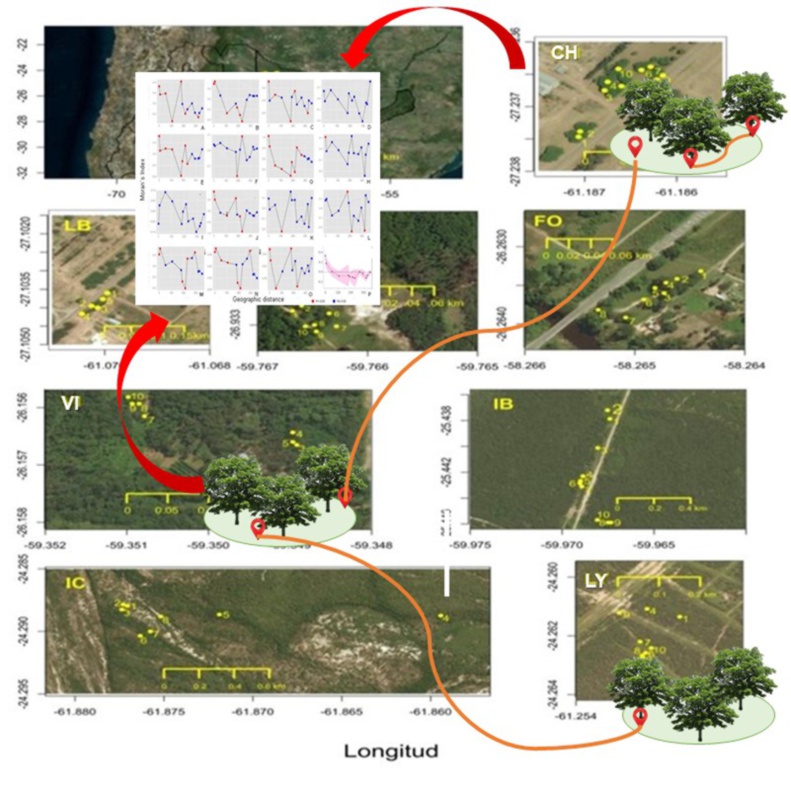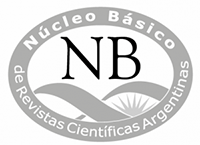Estructura espacial de caracteres fenotípicos en siete procedencias de Neltuma alba (Fabaceae)
DOI:
https://doi.org/10.31055/1851.2372.v58.n4.39224Palabras clave:
adaptativos, análisis, , origen, rasgos, Neltuma, ProsopisResumen
Introducción: Neltuma alba es una de las leñosas nativas más importantes de Argentina. Ocupa la ecorregión de Gran Chaco y parte de la Mesopotamia Argentina. Muestra gran variabilidad parcialmente atribuida a hibridación e introgresión con otros algarrobos, asociados a la protoginia y sistemas de autoincompatibilidad. Se adapta a climas áridos y semiáridos con suelos salinos y degradados. La heterogeneidad ambiental y su amplia distribución pueden asociarse a adaptación local y autocorrelacionados espacial en variables genéticas y cuantitativas. Objetivo: Analizar la estructura espacial en procedencias de N. alba influenciada por el aislamiento por distancia en la Región del Gran Chaco.
M&M: Se evaluó la autocorrelación en siete procedencias de N. alba de las ecorregiones del Chaco Seco y el Chaco Húmedo, basado en quince rasgos foliares, de fruto y germinación en 68 individuos adultos, incluyendo información de cinco variables ambientales.
Resultados: los análisis estadísticos univariados demostraron diferencias significativas o altamente significativas entre procedencias. La asociación entre la similitud fenotípica y la distancia geográfica mostró valores de autocorrelación significativa para la primera clase de distancia (0-0.643 km). El test de Mantel parcial indicó que la correlación entre la distancia fenotípica y geográfica se pierde a partir de 40 - 50 km. El análisis global mostró que 11 de los rasgos analizados presentaron una autocorrelación significativa. El análisis espacial local indicó que para varios rasgos existen puntos de alta similitud entre individuos vecinos (hotspots) y puntos donde los individuos cercanos están muy diferenciados (coldspots).
Referencias
AGUIRRE MOLARES, A. 2017. Distribution patterns and genetic structure of Cedrela odorata and Albizia saman for the ecological conservation and restoration for the tropical dry forest in Colombia. Thesis of Master in Biological Sciences. University National of Colombia, Colombia [online]. Available in: https://repositorio.unal.edu.co/bitstream/handle/unal/59023/1060651111.2017.pdf?sequence=1&isAllowed=y [Access: 20 september 2023].
BENJAMINI, Y. & Y. HOCHBERG. 1995. Controlling the false discovery rate: a practical and powerful approach to multiple testing. J. Roy. Stat. Soc. A Sta. 57: 289-300. https://doi.org/10.1111/j.2517-6161.1995.tb02031.x
BESEGA, C., L. FERREYRA, N. JULIO, S. MONTOYA, B. SAIDMAN & J. VILARDI. 2000. Mating system parameters in species of genus Prosopis (Leguminosae). Hereditas 132: 19-27. https://doi.org/10.1111/j.1601-5223.2000.00019.x
BESEGA, C., C. POMETTI, M. EWENS, B. SAIDMAN & J. VILARDI. Strategies for conservation for disturbed Prosopis alba (Leguminosae, Mimosoidae) forests based on mating system and pollen dispersal parameters. 2012. Tree Genet. Genomes 8: 277-288. https://doi.org/10.1007/s11295-011-0439-6
BESSEGA, C., C. POMETTI, M. EWENS, B. SAIDMAN & J. VILARDI. 2015. Evidences of local adaptation in quantitative traits in Prosopis alba (Leguminosae). Genetic 143: 31-44. https://doi.org/10.1007/s1070 9-014-9810-5
BESSEGA, C., C. POMETTI, B. SAIDMAN & J. VILARDI. 2017. Contribución de estudios genético poblacionales a la conservación de especies nativas de argentina de interés forestal. Ciencia e Investigación 67: 25-35.
BESSEGA, C., J. VILARDI, M. CONNY, B. SAIDMAN & C. POMETTI. 2022. Low genetic variation of foliar traits among Prosopis chilensis (Leguminosae) provenances. J. Plant Res. 135: 221-234. https://doi.org/10.1007/s10265-022-01378-9
BURKART, A. 1976. A monograph of the genus Prosopis (Leguminosae Subfam. Mimosoideae). J. Arnold Arb. 57: 219-249, 450-525.
CASTILLO, M., U. SCHAFFENER, B. van WILGEN, N. MONTAÑO, R. BUSTAMANTE, A. COSACOV, M. MATHESE & J. LE ROUX. 2021. Genetic insights into the globally invasive and taxonomically problematic tree genus Prosopis. AoBP Plants 13: 1-13. https://doi.org/10.1093/aobpla/plaa069
CONTRERA DIAZ, R., M. GONZALEZ GONZALEZ, F. AGUAYO CRUCES, S. GACITUA ARIAS & V. PORCILE SAAVEDRA. 2021. Analysis of the diversity and genetic structure of Prosopis chilensis populations between the provinces of Chacabuco and San Felipe de Aconcagua, using microsatellite molecular markers. Bosque (Valdivia) 42: 371-382. http://dx.doi.org/10.4067/S0717-92002021000300371
DARQUIER, M., C. BESSEGA, M. CONNY, J. VILARDI & B. SAIDMAN. 2013. Evidence of heterogeneous selection on quantitative traits of Prosopis flexuosa (Leguminosae) from multivariate QST–FST test. Tree Genet. Genomes 9: 307-320. https://doi.org/10.1007/s11295-012-0556-x.
DJAVANSHI, K. & H. POURBEIK. 1976. Germination Value - a new formula. Silvae Genetica, 25: 79-83 [online]. Available in: https://www.thuenen.de/media/institute/fg/PDF/Silvae_Genetica/1976/Vol._25_Heft_2/25_2_79.pdf. [Access: 20 september 2023].
FONTANA, M., V. PEREZ & C. LUNA. 2018. Effect of the geographic origin in the morphological quality of Prosopis alba (Fabaceae) plants. Rev. Biol. Trop. 66: 593-604. http://dx.doi.org/10.15517/rbt.v66i2.33383.
GARCIA, C. 2019. Integrating the demographics and genetics of populations through the landscape genetics. Ecosistemas 28: 75-90. https://doi.org/10.7818/ECOS.1694.
GETIS, A. & J. ORD. 1992. The analysis of spatial association by use of distance statistics. Geogr. Anal. 24: 189-206. https://doi.org/10.1111/j.1538-4632.1992.tb00261.x
GONCALVES, L. 2019. Special genetic structure in fragmented landscapes: A study of natural populations of curupay (Leguminosae): Anadenanthera colubrina var. cebil). Doctoral Thesis. University National of La Plata, Argentina. [online]. Available in: http://sedici.unlp.edu.ar/bitstream/handle/10915/73663/Documento_completo.pdf-PDFA2u.pdf?sequence=1&isAllowed=y. [Access : 20 september 2023]
HIJMANS, R. 2019. Raster: Geographic Data Analysis and Modeling. R package versión 2.9-23. https://CRAN.R-project.org/package=raster.
HUGHES, C., J. RINGELBERG, G. LEWIS & S. CATALANO. 2022. Desintegration of the genus Prosopis L. (Leguminosae, Caesalpinioideae, mimosoid clade). PhytoKeys 205: 147-189. https://doi.org/10.3897/phytokeys.205.75379.
MORAN, P. 1950. Notes on continuous stochastic phenomena. Biometrika 37: 17-23. https://doi.org/10.2307/2332142.
MORELLO, J., S. MATTEUCCI & A. RODRIGEZ. 2012. Ecorregiones y complejos ecosistemicos argentinos. 1st ed. Orientación Gráfica Editora. Bs. As.
ORD, J. & A. GETIS. 1995. Local spatial autocorrelation statistics: distributional issues and an application. Geogr. Anal. 27: 286-306. https://doi.org/10.1111/j.1538-4632.1995.tb00912.x.
ORTIZ, N., S. GIANNONI & R. PAZ. 2018. Spatial genetic structure and genetic diversity of a natural population of Ramorinoa girolae in San Juan province (Argentina): An exploratory analysis. Ecol. Austral 28: 513–524. https://doi.org/10.25260/EA.18.28.3.0.604.
PALACIOS, R. & L. BRAVO. 1981. Natural Prosopis (Leguminosae) hybridization in Argentina’s Chaco Region. Morphological and chromatographic evidences. Darwiniana 23: 3-35.
R CORE TEAM. 2020. R: A language and environment for statistical computing. R Foundation for Statistical Computing, Vienna, Austria. http://www.R-project.org (Versión 4.0.3).
ROSER, L. 2017. Genetics of the landscape in Prosopis alba populations from the province of Santiago del Estero. Doctoral Thesis. University of Buenos Aires.
ROSER, L., L. FERREYRA, B. SAIDMAN & J. VILARDI. 2017. EcoGenetics: An R package for the management and exploratory analysis of spatial data in landscape genetics. Mol. Ecol. Resour. 17: e241-e250. https://doi.org/10.1111/1755-0998.12697
SAIDMAN, B. & J. VILARDI. 1993. Genetic variability and germplasm conservation in the genus Prosopis. In: PURI, S., P.K. KHOSLA (eds.), Nursery Technology for Agroforestry: Applications in Arid and Semiarid Regions. pp. 187-198. Winrock-Oxford & IBH Publishing Co., New Delhi.
SIABATO, W. & J. GUZMAN MANRIQUE. 2019. Spatial autocorrelation and development of quantitative geography. Cuad. Geogr. Rev. Colomb. Geogr. 28: 1-22. https://doi.org/10.15446/rcdg.v28n1.76919.
SILVA, J. & J. NAKAGAWA. 1995. Estudo de Fórmulas para cálculo da velocidade de germinação. Informativo Abrates 5: 62-73.
TEICH, I., M. MOTTURA, M. BALZARINI & A. VERGA. 2015. Association between genetic and phenotypic variability with adjustment for spatial autocorrelation in Prosopis. Journal of Basic and Applied Genetics 26: 63-74.
VILLAREAL, M. 2018. Effect of the Cedrela odorata L genetic variability management in the State of Hidalgo. Thesis of Master in Biodiversity and Conservation Sciences. México.
WANG, I. & G. BRADBURG. 2014. Isolation by environment. Mol. Ecol. 23: 5649-5662. https://doi.org/10.1111/mec.12938.
WRIGHT, S. 1943. Isolation by distance. Genetics 28: 114-138. https://doi.org/10.1093/genetics/28.2.114

Descargas
Publicado
Número
Sección
Licencia
Derechos de autor 2023 Maria Victoria Vega

Esta obra está bajo una licencia internacional Creative Commons Atribución-NoComercial-SinDerivadas 4.0.
El Bol. Soc. Argent. Bot.:
- Provee ACCESO ABIERTO y gratuito inmediato a su contenido bajo el principio de que hacer disponible gratuitamente la investigación al público, lo cual fomenta un mayor intercambio de conocimiento global.

- Permite a los autores mantener sus derechos de autor sin restricciones.
- El material publicado en Bol. Soc. Argent. Bot. se distribuye bajo una licencia de Creative Commons Atribución-NoComercial-CompartirIgual 4.0 Internacional.











